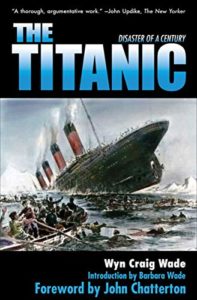
Through miscellaneous readings, and history-type TV shows, I know a fair amount about the Titanic disaster. I had never read a complete book on it, however. I bought The Titanic: Disaster of a Century by Wyn Craig Wade. I had seen this on a bookshelf somewhere, read a few pages in it during an idle moment, and decided it would be good to have. Amazon is my friend, and I soon had a new copy, purchased with a gift certificate.
The book did not in any way prove a disappointment. It was originally published in 1980, before the discovery of the wreck later in that decade. This was an updated version, published as a centenary edition in 2012. Mr. Wade had died in the meantime, and his daughter, Barbara Wade, completed and published this updated edition.
It starts with the news that the Titanic had struck ice and was in trouble. It followed the early reports: first the bare news of contact with ice, followed by reports of damage, followed by reports of all souls rescued and being brought to Halifax, followed by reports that Titanic was being towed to Halifax with all souls on board, followed by the Titanic sank but all souls were on another ship heading for New York.
The book spent a long couple of chapters on this, showing the lack of information and disinformation. Eventually the rescue ship, the Carpathia, arrives in New York and the truth becomes known, how 2/3 of the souls aboard had been lost, how the lifeboats had not been fully loaded, etc.
Into this steps the senator from Michigan, William Alden Smith. He rushes to New York City with a subpoena for J Bruce Ismay, president of the White Star Lines and one of those rescued, who was hoping to skedaddle back to England and avoid an American inquiry. The chapters moved into the hearings held, first in New York then in Washington DC. Through these hearings the story of the disaster came out.
I thought that was an interesting literary technique by Wade. Rather than follow the ship from its points of departure in the British Isles, it concentrated on the decisions that contributed to the disaster. How the crew hadn’t been well trained and didn’t know the ship. How a lifeboat drill had been cancelled the morning of the last day. How ice warnings conveyed by other ships had been noted and ignored by the captain who had never had a bad thing happen in 40 years at sea. How various vessels responded to Titanic’s SOS. How unregulated wireless “traffic” hindered rescue attempts and news forwarding. How the Californian was within sight of Titanic but did nothing to help, their captain apparently not really understanding what was going on.
The book is well-written, well-organized. I enjoyed it immensely, and read the 318 pages in thirteen sittings. I give it 5-stars, and will likely do a review on Amazon.
Is it a keeper, however? I have too many books, and need to begin to get rid of some. I’m not yet ready to get rid of this, however. I’ll pull another book from the shelf, one I’m sure I’ll never re-read, let it go, and keep this.